Transformative Small Bathroom Makeovers: A Visual Guide


Intro
In today's world, where space is often at a premium, the smallest rooms in our home deserve just as much attention as the larger ones. The bathroom, in particular, is a sanctuary for many, providing a retreat from the chaos of daily life. Yet, a small bathroom can sometimes feel cramped and uninspiring. Fear not! With a little creativity and the right approach, even the tiniest of bathrooms can be transformed into a stylish and functional haven.
Small bathroom makeovers don’t merely revolve around aesthetics; they blend practicality with design. This guide looks at various transformative approaches to revamp your bathroom in ways that maximize space and style. Whether you're a housewife looking to enhance your family’s daily routine or a homeowner seeking to boost property value, this comprehensive guide offers the insight and techniques needed to embark on a successful makeover.
From selecting ideal colors to choosing the right fixtures, the journey of transforming your small bathroom starts with careful planning, thoughtful material selection, and an eye for detail. Each step is vital, creating a cohesive design that resonates with you and elevates your bathroom experience. So roll up your sleeves and get ready to explore the endless possibilities awaiting within those four walls!
Understanding the Small Bathroom Challenge
When it comes to the realm of home renovations, small bathrooms often present a unique set of dilemmas and opportunities. These spaces, typically confined in size, challenge homeowners to be creative and strategic in their approach. A small bathroom makeover isn't merely about aesthetics; it's about transforming constraints into a canvas of innovative design solutions.
The cramped quarter of a small bathroom can feel stifling, especially during busy mornings. However, understanding the limitations can help optimize the available space, enhancing both functionality and a sense of openness. This article explores how to stretch those square feet through thoughtful planning and effective design tactics, focused on making the best use of every inch.
Common Limitations and Opportunities
Small bathrooms often come with their own series of hurdles. Limited storage options, tight footprints, and the challenge of incorporating necessary fixtures like showers, bathtubs, and sinks can be overwhelming. Despite these drawbacks, every challenge holds the seed of opportunity.
Consider these common limitations:
- Limited Square Footage: Often, there simply isn’t enough room to fit all desired features comfortably.
- Low Ceilings: For some spaces, the vertical dimension can be just as limiting as the horizontal one.
- Poor Layouts: A bathroom designed without forethought can feel even more cramped, leaving little room for movement and functionality.
Yet, with challenges come opportunities. Embracing a fresh perspective allows for creative solutions that may not initially come to mind. Employing clever storage options, utilizing vertical space, or even embracing an open-concept design can yield significant benefits. For example, wall-mounted shelves can replace traditional cabinets, freeing up floor space while still offering storage.
The Psychology of Space Perception
Perception plays a key role when it comes to small spaces. People often feel confined in tightly packed environments, leading to a sense of discomfort. Understanding the psychology behind this can be pivotal in your design approach.
Color and Light: Bright colors and ample lighting can dramatically affect how a space feels. Soft hues can open up a room, while good lighting can significantly alter perceptions of size and space.
- Mirrors: Incorporating mirrors can add depth, tricking the eye into interpreting a room as more expansive than it is.
- Transparency: Glass partitions for showers or compact designs that keep sightlines clear help maintain a feeling of openness.
Ultimately, tackling the small bathroom challenge involves navigating the interplay between function and psychology. By keeping the principles of design in mind and recognizing how the elements of a room affect mood and perception, homeowners can create an inviting and practical sanctuary amidst the constraints.
"Small spaces demand our creativity and our best design instincts; the reward is a cozy lavatory that feels anything but cramped."
The conversation isn't just about making do in a small space; it's about creating an enjoyable environment that feels perfectly tailored for the homeowners. With the right approaches, a small bathroom can transform into a thoughtfully designed oasis, demonstrating that sometimes, less really is more.
Design Principles for Small Bathrooms
When dealing with a small bathroom, the stakes can feel high. The purpose here isn’t just to remodel, it’s to maximize every square inch while treading the fine line between functionality and aesthetics. Well-considered design principles can be a game-changer, ensuring the space not only serves its intended function but also creates a pleasing atmosphere.
The importance of embracing design principles in small bathrooms cannot be overstated. Without a strategy, you risk cluttered spaces and misguided layouts. An effective design not only boosts your space's usability but refines the vibe, making it a retreat rather than merely a utility room.
Maximizing Vertical Space
The ceiling may seem like just another boundary in a small bathroom, but it’s an underutilized hero in your quest for space optimization. Think of your walls as canvases where style and storage meet. Open shelves that stretch up towards the ceiling use verticality to your advantage, allowing you to display stylish jars or plants while keeping essentials within easy reach.
Mounting cabinets higher than standard can add significant storage without encroaching on your walkable area. Toss in some hooks or pegs above the toilet for towels or robes — it’s all about thinking upwards! Remember, if you have an eye for style, you can transform that vertical space into something more than just extra storage:
- Crown molding can add a touch of elegance while drawing the eyes upward.
- Tall mirrors extend the visual landscape, creating depth.
"In a small bathroom, height is your ally - use it well."
Color Theory and Its Application
Color has a colossal impact on how we perceive space. In the context of a small bathroom, choosing the right colors can open up the area, making it feel far more spacious than it actually is.
Lighter shades, particularly whites and soft pastels, can reflect light beautifully, creating an airy feel. Think about using a soft mint or pale lavender for a gentle yet inviting atmosphere. Dark colors, while sophisticated, can make a compact space feel like a cave unless used strategically.
Moreover, utilizing color as a design feature can guide the eye throughout the space. Consider:
- Accent walls: A bold color on one wall can provide a striking focal point without overwhelming the entire room.
- Transitional colors: Blending tones on different surfaces—like walls and tiles—can soften transitions and maintain flow.
Choosing the Right Fixtures and Materials
Fixtures and materials can set the tone for your bathroom's overall design. Choosing the right ones not only contributes to aesthetics but can enhance functionality and longevity.
Opt for wall-mounted faucets or sinks to free up counter space, making the area feel less congested. Compact vanities with built-in shelves can retain stylish appearances while adding necessary storage. Materials like porcelain tile or glass are excellent picks, as they can resist moisture while providing a clean, sleek look.
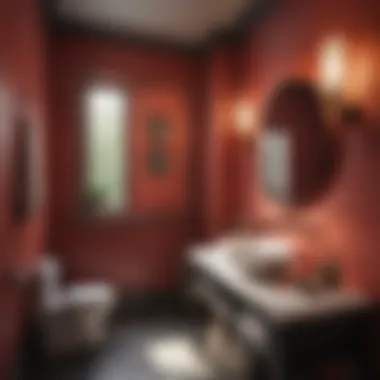
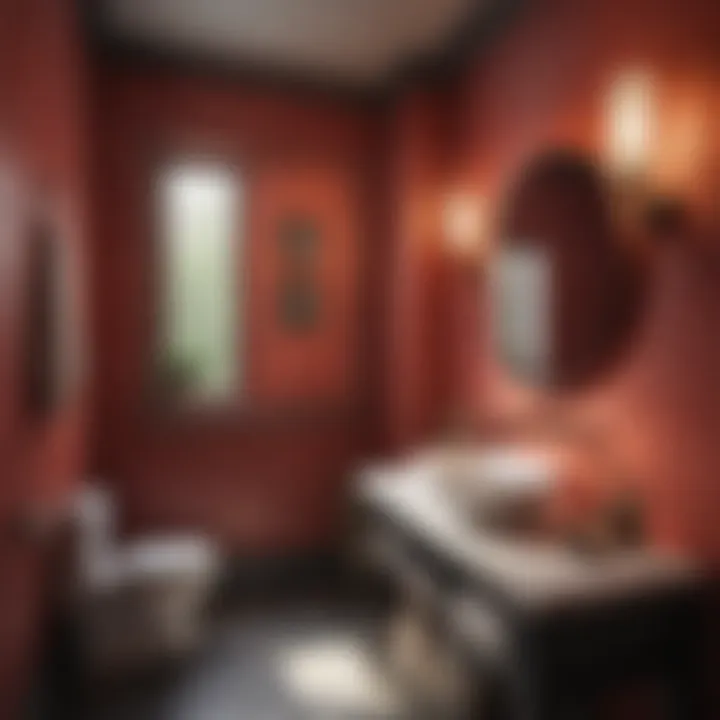
A few considerations while picking:
- Get savvy with scale: Larger tiles can visually expand the space but may require skilled laying.
- Mix materials mindfully: Wood and metal can contrast stylishly but ensure they complement rather than clash.
In striking a balance between style and practicality, your choices can elevate the bathroom experience without sacrificing precious space.
In summary, integrating these design principles can completely reshape small bathrooms into stylish havens. Whether it's reaching for vertical storage, considering color intricately, or making careful choices about fixtures, the right approach can leave no corner neglected.
Innovative Layouts for Small Bathrooms
Creating a small bathroom can feel like trying to fit a square peg in a round hole, but with the right layouts, this challenge becomes an opportunity for innovation. The key to a successful small bathroom makeover lies not just in aesthetics but in practical functionality. Adequate planning on how the space is utilized can lead to significant improvements in how these areas serve the household. In considering layouts, housewives and homeowners will find the benefits can range from enhanced flow, better utilization of space, and improved access to each feature.
Open-Concept Designs
Open-concept designs are becoming quite the rage in modern homes, and for good reason. They let in more light and create a sense of spaciousness that is often missing in traditional small bathrooms. By eliminating unnecessary walls, homeowners can create a fluid transition between spaces. This method can make the bathroom feel larger, even if the square footage remains relatively small.
One example might be removing a solid barrier between the bathroom and an adjacent bedroom or utility space. Instead of viewing it as just a bathroom, the room can take on the character of a luxurious suite. Using glass partitions can also maintain the openness while providing necessary privacy.
"Transforming the perception of size in your home often comes down to removing what confines—walls can sometimes be the first hurdle to tackle."
Integrating elements like hanging shelves in lieu of bulky cabinetry or using a wall-mounted sink are additional ways to enhance openness, allowing for more floor space and freer movement.
Corner Bathroom Solutions
When dealing with confined spaces, corners can turn into untapped gold mines. Many forget that the corners of a bathroom can serve practical purposes. Utilizing corner sinks or toilets can open up room for other fixtures, or simply create areas that feel less cramped.
One common solution is a corner shower enclosure. These show up in various shapes, from triangular to quarter-circle, allowing those often wasted areas to become functional. A corner vanity can also fit snugly into little nooks without taking away from maneuverability.
Investing in tall shelving units that run up the height of the corner can help maximize storage without interference. Mirrored corner cabinets can reflect light and make the room appear larger while providing ample place to stow bathroom essentials.
Shower vs. Bathtub Dilemmas
When considering layouts, many homeowners wrestle between installing a shower or a bathtub. It’s a classic conundrum, especially in smaller bathrooms. Bathtubs, while luxurious, can consume much of the floor space, leaving little room for movement. Alternatively, showers often deliver practicality in a more compact design.
Here, the trick lies in recognizing the lifestyle needs of the residents. For those with young children, a bathtub might be non-negotiable. However, if time-savings and accessibility are paramount, a sleek, modern shower may be the route to take.
There are options, too, that can marry both desires. Designs incorporating shower-bathtub combos have grown sophisticated, allowing homeowners to luxuriate in a soaking tub while reaping the benefits of a fast rinse-off.
Ultimately, choosing between a shower and bathtub isn't just about fitting an appliance in the space—it's about designing a bathroom that serves the family's unique needs while maximizing available square footage.
In summary, innovative layouts transform small bathrooms from seemingly lifeless spaces into well-thought-out retreats that reflect personal style and functional living. Consider these practices, and you may see what once felt like limitations morph into opportunities.
Inspiration from Real Transformations
In the world of small bathroom makeovers, the phrase "seeing is believing" rings particularly true. Real transformations serve as a rich source of inspiration for current or aspiring homeowners who face similar challenges in their own spaces. By examining the ways others have turned their cramped baths into functional and stylish retreats, one can gain insights into possibilities that may not have been considered before.
Bringing life into limited space isn't just about choosing the right tiles or fixtures; it’s about understanding the styles that resonate with individual tastes while catering to practical needs. The benefit of reviewing before and after images is two-fold. First, it showcases tangible outcomes, illustrating the profound effects of thoughtful design choices on small areas. Second, it heightens one’s awareness of how critical small details, such as lighting or storage solutions, can dramatically change a room’s aesthetic and usability.
Examples of these transformations offer tangible guidelines—like effective layout changes or color schemes—that can spark ideas for anyone planning their own renovations. From clever storage hacks to unexpected design features, these transformations highlight the versatility that can exist within the confines of a small bathroom.
Before and After Comparisons
Analyzing before and after photos provides a unique lens through which one can understand the potentials of a small bathroom. The sheer contrast between the uninspiring state of a space and its revitalized look often underscores the power of innovative design. Not only do these images evoke a sense of wow-factor, but they also offer practical examples of how functionality can be enhanced alongside aesthetics.
For instance, imagine a previously cluttered bathroom burdened with an oversized vanity, casting shadows on what little space existed. A transformation into a lighter, brighter version—with wall-mounted shelves and a compact sink—illustrates how easy it is to reclaim space. Additional elements, such as floatting shelves or sleek, integrated storage solutions, showcase practical adjustments that invite organization and simplicity into the design.
Stylish and Functional Updates
Simply freshening decor can yield fantastic results, yet today’s homeowners increasingly seek updates that marry style with function. These updates can take many forms, from the smallest accessories to larger structural changes. One key consideration is the selection of fixtures that balance practicality with elegance. A contemporary rain shower head not only adds a touch of luxury but can also create an open, airy feel, even in modest rooms.
Another angle to explore is the introduction of innovative textiles, such as plush rugs or bold shower curtains, providing texture and color. These stylistic choices can significantly influence the mood without demanding extensive renovations. Additionally, mirror placements are crucial. A strategically placed mirror not only enhances brightness but also creates the illusion of more space, effectively doubling its perceived size.
Highlighting Specific Design Features
Every small bathroom has the potential for standout features that make it distinctive. One might think of unique wall treatments, lighting choices, or clever space-saving furniture. A recent trend is the integration of natural materials, such as wood accents or stone tiles, which can invoke a sense of calm and richness in small dimensions.
Take, for instance, a bathroom where the only wall separates the shower area from the toilet—opting for glass panels in place of traditional walls can open up the space and offer a modern, sleek appeal. Alternatively, artwork or sculptural elements can serve as focal points, encouraging a personal touch even in a compact area.
"An effective design can transform limited space into a canvas for your imagination."
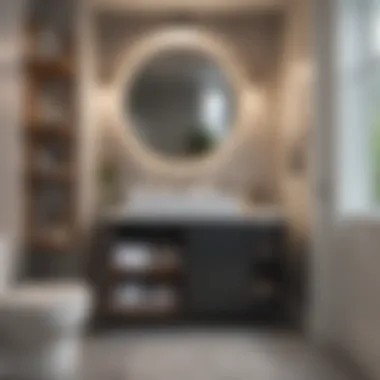
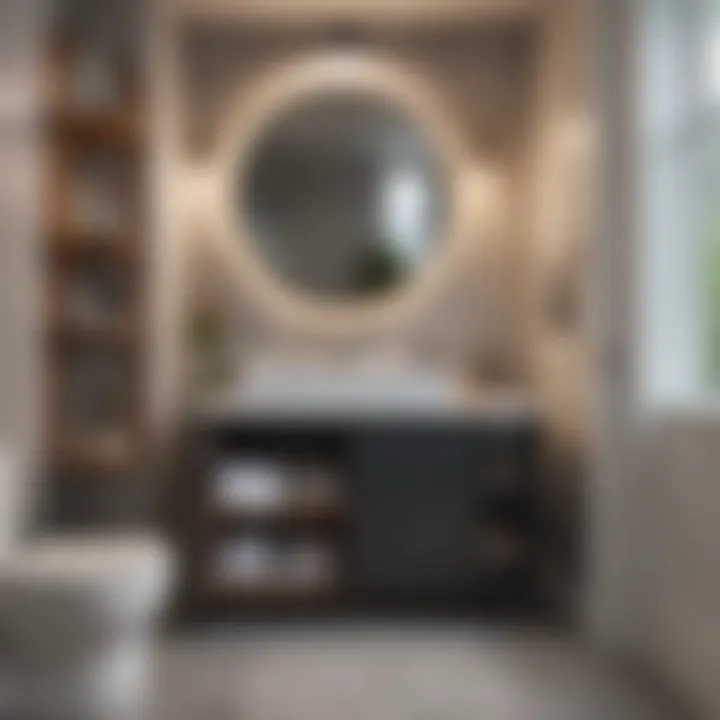
The notion of highlighting design features isn’t just about aesthetics; it's about creating an environment that embodies your personal style, all while maximizing the utility of every square inch.
In essence, the inspiration drawn from real transformations is invaluable. With the examples and insights gleaned from these experiences, homeowners are better equipped to embark on their projects. Owning a small bathroom doesn’t mean one must compromise on style or function; by learning from others who have tread this path, each individual’s vision can blossom.
Selecting a Cohesive Color Palette
Choosing the right color palette for a small bathroom is more than just a design decision; it’s a strategic maneuver that can significantly alter the perception of the space. In a small bathroom, colors play a pivotal role in creating an illusion of expansiveness while maintaining harmony in design. This part of your bathroom makeover can either elevate the space or make it feel cramped and chaotic. Understanding the benefits and considerations surrounding your color choices is essential to achieving the desired outcome.
Neutral Tones: Calm and Spacious
Neutral tones are often heralded as the go-to choice for creating a serene and spacious feel in small bathrooms. Shades like soft beige, pale gray, and off-white act as an unobtrusive backdrop that visually expands the area. These colors don’t compete for attention; instead, they cradle other elements of the room, allowing them to shine in their own right.
Imagine stepping into a bathroom painted in a soft dove gray. Immediately, a sense of tranquility envelops you, no flashiness—just calm sophistication. Neutral colors also tend to reflect light, which can help a small space feel airier and fresher. Plus, they pair easily with a variety of fixtures and accessories.
On the practical side, neutral palettes provide flexibility. If your tastes change or you want to refresh your decor down the line, adding colorful towels or decorative accents allows you to easily shift the vibe without repainting. Here’s a quick rundown of the advantages of neutral tones:
- Versatility: Works well with many styles and materials.
- Timelessness: Offers a lasting appeal that doesn’t go out of fashion.
- Illusion of Space: Makes smaller areas feel more open and inviting.
However, don't shy away from mixing slight variations of neutral tones to add depth. For instance, combining warm and cool undertones can achieve a rich, layered look without overwhelming a compact area.
Bold Accents: Making a Statement
While neutral tones work wonders, bold accents can make your small bathroom pop, adding personality and visual intrigue. Using vibrant colors, such as deep blues or striking greens, can serve as captivating focal points. Think of a navy vanity against white walls, creating a chic contrast that draws the eye and brings a splash of life into the room.
The trick, when opting for bold colors, is to use them judiciously. Accents can come across through accessories, an accent wall, or even colorful tiles. This strategy allows for an expressive design without overloading the senses. Here are some ways to smartly implement bold accents:
- Accent Walls: Paint one wall a bold color to create a focal point, while keeping the others neutral.
- Decor Items: Use vibrant towels, artwork, or plants to add layers of color without permanent changes.
- Ceramic Tiles: Introduce hue through patterned or colorful tiles on the floor or as a backsplash to add character.
By carefully selecting where and how to incorporate these daring shades, you can ensure your small bathroom strikes the right balance between becoming a sanctuary and a statement zone. The key lies in the harmony between the bold and the subtle; they must coexist without clashing, harmonizing instead to create a cohesive aesthetic that leaves a lasting impression.
"Color is the keyboard, the eyes are the harmonies, the soul is the piano with many strings." - Wasilly Kandinsky
Accessorizing with Intention
Accessorizing is often the final touch that transforms a small bathroom from an everyday space into a sanctuary of comfort and style. While large bathrooms can afford a few splashes of personality here and there, every inch of a small bathroom counts. Meaningful accessory choices can accentuate designs, create focal points, and maximize function—all while maintaining an aesthetic that resonates with homeowners' sensibilities. With limited space at play, each accessory should enhance the overall design rather than complicate it.
Functional Accessories that Elevate Design
When it boils down to functionality, accessories must pull their weight. Think about pieces that serve dual purposes, providing both utility and style. Here are some key examples:
- Wall-mounted Shelves: These are high on the list for good reason. They not only free up floor space but can also act as platforms for decorative plants or candles, adding a personal touch.
- Mirrors: A classic bathroom accessory, mirrors can make small spaces appear larger. Opt for models with built-in storage or unique framing to add character.
- Storage Baskets: Baskets made of natural fibers can neatly store toiletries while contributing texture and warmth to the room. Consider shades that complement your color palette.
- Matte Black or Brass Fixtures: These can elevate a simple setting, pulling the eye to focal areas without overwhelming other design elements.
By selecting accessories that contribute to usability while also reflecting personal style, homeowners can create a more enjoyable and efficient space. Accessories should tell a story—every piece should have a purpose or history, transforming the bare essentials into a curated collection.
Choosing Textiles and Patterns
When it comes to textiles, small bathrooms can benefit from strategic choices regarding patterns and colors. Textiles—be it towels, shower curtains, or bath mats—can transform the overall feel of the space. Here are considerations to keep in mind:
- Color Compatibility: Consider how your textiles will complement your chosen palette. If your walls are painted in soft neutrals, bold patterns in towels can make them pop.
- Pattern Selection: Small spaces benefit from textiles that offer a visual respite through repetition or continuity. Look for subtle patterns or textures that add depth without feeling cluttered.
- Layering Textiles: Don't shy away from mixing textiles. For instance, combine a patterned shower curtain with solid bath mats that echo the curtain’s hues or patterns but balance the visual weight.
- Durability and Maintenance: It isn’t all about looks. Choose materials that stand up to moisture and provide ease of cleaning. Water-resistant textiles can offer longevity while keeping the aesthetic intact.
In the end, textiles should harmonize with the design and enhance the tactile experience of the space. Well-chosen fabrics offer warmth, comfort, and even a touch of luxury. Transform mundane bathrooms into inviting retreats, all through the power of thoughtful accessorizing.
"Every accessory is a statement. The collection you curate adds layers to the design, unlocking the full potential of your small bathroom."
When the approach is intentional, homeowners not only see an immediate enhancement in functionality but also witness a shift in how they experience their space—making their small bathroom a true reflection of who they are.
Lighting Solutions for Small Spaces
Lighting is often the unsung hero in bathroom design. In small spaces, every detail counts, and the right lighting can open up a room, making it feel larger and more inviting. It's not just about brightness; it's about creating an ambiance that complements the overall design while ensuring practicality. Think of lighting as the frame around the picture, accentuating the beauty within.
Natural Light Considerations
Embracing natural light is paramount in small bathrooms. A well-placed window not only brightens the space but also connects it with the outdoors, providing a breath of fresh air, both literally and figuratively. If your bathroom has a window, consider going with sheer curtains or no curtains at all to maximize light intake.
To make the most of available sunlight:
- Opt for skylights: If you can, install skylights that can let in more light without compromising privacy.
- Use reflective surfaces: Mirrors and glass can bounce natural light around the room, creating a wider appearance. A mirrored cabinet above the sink can double up on storage while reflecting light back into the space.
Taking full advantage of natural light can lead to a room that feels both spacious and vibrant. Failing to do so, however, can leave the space feeling cramped and dull, which is precisely what one wants to avoid.
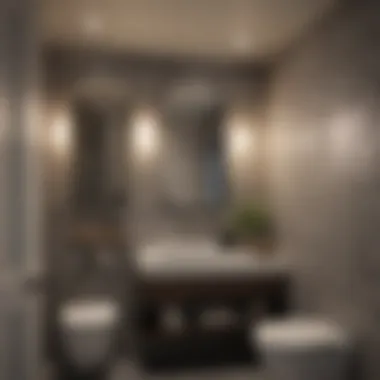
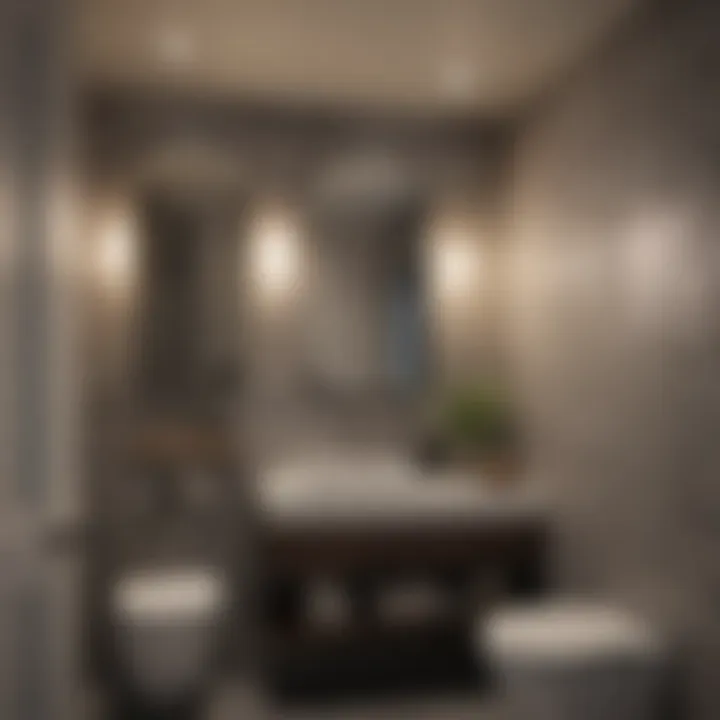
Layered Lighting Techniques
Layering lighting is a game-changer for small bathrooms. It involves using three types of lighting: ambient, task, and accent. By thoughtfully combining these, you can achieve a well-lit and visually interesting space.
- Ambient Lighting: This is your general lighting, which provides an overall glow. Ceiling-mounted fixtures or recessed lighting can work wonders here, casting light across the room evenly. Dimmable options can give you flexibility to set the mood, whether you want a bright morning routine or a softer evening ambiance.
- Task Lighting: For activities such as grooming, having adequate task lighting is essential. Sconces beside the mirror or specialized fixtures that illuminate just the vanity area make for excellent choices. Bright, direct lighting here eliminates shadows, ensuring that getting ready is as easy as pie.
- Accent Lighting: Don’t be shy about showcasing the beauty in your bathroom. Accent lights can highlight special features like artwork or architectural details. Perhaps a small LED spotlight on a lovely tile feature or a backlit mirror can elevate the room’s overall aesthetic.
Incorporating layered lighting techniques creates a dynamic atmosphere, allowing you to adjust settings for various tasks and moods. As one might say, it’s like having your cake and eating it too—getting all the function without sacrificing style.
"A well-lit bathroom is more than a comfort; it's an invitation to transform daily routines into enjoyable experiences."
Thus, ambitious bathroom makeovers should definitely consider the significance of lighting. It has the power to uplift a small space by enhancing its features. Remember that a little creativity can go a long way, making even the tiniest bathrooms feel open and inviting.
Materials Selection
The choice of materials in a small bathroom makeover can make or break the design. Smart material selection holds the key to maximizing both aesthetics and functionality. Every element, from tiles to fixtures, plays a hard-hitting role in transforming cramped quarters into chic retreats. When planning a small bathroom renovation, it’s crucial to consider how materials not only complement each other but also stand the test of time — financially and functionally.
Tile Choices and Trends
Tiles are not just for flooring; they work wonders on walls and even ceilings. Opting for the right tile can significantly alter the perception of space. Here are several factors and trends to consider:
- Larger Tiles: Large-format tiles minimize grout lines, giving a seamless appearance that can make a room feel more expansive. Think of a polished porcelain tile or sleek ceramic that reflects light, brightening up the space.
- Subway Tiles: Classic white subway tiles are undergoing a revival. Consider laying them in a herringbone pattern for a modern twist. The simplicity of their design can blend well with both contemporary and traditional themes.
- Mosaic Tiles: For added flair, install mosaic tiles as accents. They can be utilized in shower niches or as a statement backsplash. Their variety in colors and textures offers almost limitless creative possibilities, catering to distinct tastes.
When selecting tile, keep durability in mind. Bathrooms are prone to humidity, so moisture-resistant materials are a must. Additionally, textured tiles can add a touch of luxury, yet it's also necessary to ensure they don't become slippery when wet.
Vanities and Sink Options
Choosing the right vanity and sink is more than just aesthetic appeal; it's about maximizing utility in a limited space. Here are essential considerations:
- Floating Vanities: These are a game-changer for small bathrooms as they create the illusion of more floor space. By elevating the vanity off the ground, you can visually stretch the room while providing storage underneath for neatly hidden essentials.
- Compact Designs: Look for vanities that come with integrated sinks to save counter space. Styles like pedestal sinks and corner sinks are excellent ways to fit into tight spots without compromising on style.
- Storage Solutions: Opt for vanities that offer built-in storage such as drawers or shelves. In a small bathroom, having places to store toiletries, cleaning supplies, and towels can help maintain an uncluttered aesthetic.
Remember, functionality is just as important as appearance; your selected materials should serve a dual purpose.
Pay attention to the materials themselves too. Options include chic recycled materials for the eco-conscious, or high-gloss finishes for that modern, upscale feel. Considering factors like resistance to water damage and ease of cleaning can lead to a longer-lasting and more satisfying bathroom setup. Let's face it, nobody wants to deal with repair hassles down the line!
In a nutshell, thoughtful material selection is your ally while transitioning your modest bathroom into a beautifully designed sanctuary. With the right tiles, sinks, and vanities, small spaces can truly shine!
Sustainable Practices in Bathroom Makeovers
In remodeling small bathrooms, the topic of sustainability is becoming increasingly important. As awareness grows about environmental impacts, home designers and owners alike are searching for ways to create spaces that are ecologically responsible. Not only does this appeal to the conscious consumer, but it also offers several benefits, such as lower utility bills and increased property value. In this section, we will explore eco-friendly materials and water-saving fixtures that can play a key role in transforming your small bathroom into a sustainable oasis.
Eco-Friendly Materials
When it comes to selecting materials for your bathroom makeover, opting for eco-friendly options can make a significant impact. Materials derived from renewable resources minimize harm to the environment while offering stylish aesthetics. For instance, consider using bamboo flooring. This rapidly renewable material adds warmth and elegance to the space without a hefty environmental price tag.
Another great choice is recycled glass tiles. These not only come in various colors and designs but also help reduce waste by repurposing materials that would otherwise end up in landfills. In addition to being a beautiful alternative, glass tiles are durable and can help reflect light, making your small bathroom appear even larger.
Utilizing low-VOC (volatile organic compounds) paint is also a practical decision when redesigning your space. These paints contribute to better indoor air quality by reducing harmful fumes typically associated with traditional paints. A few coats of fresh color not only brighten the space but can create a more health-conscious environment.
"Choosing the right materials is the first step toward ensuring your bath renovation is as kind to the planet as it is to your home."
Finally, think about cabinetry and vanity options that incorporate reclaimed wood. This approach not only adds character but also tells a story of resourcefulness and creativity. The use of salvaged materials can lend a distinctive charm that new materials often cannot achieve.
Water-Saving Fixtures
Water conservation is another crucial aspect of sustainable bathroom makeovers. The installation of water-saving fixtures can have an immediate effect on reducing water usage without sacrificing performance. Dual-flush toilets, for example, allow users to select the appropriate flush based on waste type, significantly decreasing unnecessary water use.
Furthermore, low-flow showerheads and faucets deliver the same satisfying experience while using less water. Many modern designs maintain excellent pressure even at reduced consumption levels, meaning you won’t even notice a difference in your daily shower routine. Some fixtures even come with built-in aerators that mix air with water, creating a more voluminous flow while conserving gallons.
Don’t forget about the potential benefits of reclaiming greywater from sinks and showers, which can be reused for irrigation or toilet flushing. While this may require additional plumbing work and consideration, it’s a fantastic way to enhance your bathroom’s sustainability.
As you contemplate your small bathroom makeover, remember that implementing these sustainable practices not only contributes to a more eco-friendly home but often results in lower costs and improved comfort. The combination of thoughtful material choices and water-efficient fixtures can make a world of difference, leading toward a greener future for bathroom design.
Concluding Thoughts
In this journey through the labyrinth of small bathroom makeovers, the importance of effective design cannot be overstated. Each aspect discussed serves not just as a guideline but as a launching pad for new ideas that can remarkably enhance one’s living space, specifically in such intimate areas as bathrooms. Maximizing functionality while maintaining aesthetics is a balancing act that every homeowner should take seriously. This article emphasizes how small bathrooms, often overlooked or regarded simply as utilitarian spaces, can become personal sanctuaries with thoughtful planning.
The Future of Small Bathroom Designs
Looking ahead, the horizon of small bathroom design is rich with potential. Advancements in technology and an increase in eco-awareness are blending to offer exciting opportunities. Here are some key elements to consider:
- Smart Technology Integration: The rise of smart home devices means bathrooms are increasingly outfitted with technology that improves convenience—think touchless faucets, motion-sensor lighting, or even smart mirrors that double as screens.
- Sustainable Materials: As environmental concerns grow, using eco-friendly materials is becoming the norm. This includes bamboo vanities, recycled glass tiles, and low-VOC paints. It’s not just about looking good; it’s about feeling good about the impact your choices have on the planet.
- Multi-Functional Furniture: Space-saving solutions are now more sophisticated. Floating vanities, hidden storage in walls, or mirrored cabinets that serve dual purposes are becoming the hallmark of future designs.
- Customized Solutions: Individual preferences are leading to more bespoke designs. Tailor-made cabinetry or walls that reflect personal style can transform a generic space into something uniquely yours.
In essence, the future of small bathroom designs heralds innovations that couple beauty with practicality. As homeowners become savvier, these spaces can evolve into reflections of personal identity rather than limitations. Embracing these trends allows for a transformation, turning the conventional small bathroom into a luxurious retreat. Remember, every inch counts, and in the world of design, what may initially seem like a limitation can become a source of creativity.
"In the future, smart homes will push the envelope on what small spaces can offer—innovation will be key to their evolution."
As you embark on this makeover journey, take heart in knowing that each transformative design choice you make adds not just value to your home, but also to your quality of life.







